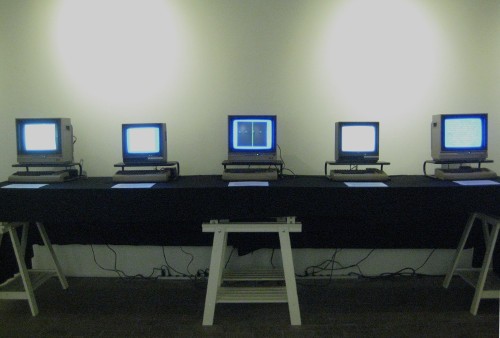Samuel Johnson’s shortsighted critique of Tristram Shandy, an 18th century novel unmatched in its day for its experimental use of typographic layout and print technology, was that “nothing odd will do long.” Nick Montfort’s new book of poems #! (pronounced shebang) would probably elicit an ?! (interrobang) from the likes of Dr. Johnson, for it builds on this tradition of visual and textual daring.
Among UNIX shell users, a #! is a character sequence that begins a text file that is to be run as a program. Montfort’s aptly titled #! consists of poetic texts presented alongside the computer programs that generated them. The poems, in new and existing forms, are inquiries into the features that make poetry recognizable as such, into code and computation, into ellipsis and into the alphabet. In a recent reading at the List Museum, Montfort (Associate Professor of Digital Media in the Comparative Media Studies program/ Writing at MIT) presented works from this volume, as well as selections from his Concrete Perl poetry, his ppg256 series and other computational poems.

Montfort works in both the lineage of programming languages and the lineage of conceptual writing and literature. The works in #! engage with the computer-generated poems of the last half century by writers and artists such as Brion Gysin and Ian Sommerville, Alison Knowles and James Tenney, Hugh Kenner and Joseph P. O’Rourke, Charles O. Hartman and others. Working in the literary tradition, however, does not preclude finding new ways to disseminate poetry. In #!, the source code is offered as free software for readers to use in their own projects, and the text-generating code is provided so that it too can be read.

Montfort has produced #! in both digital and print formats. As he points out, not only are print publications the way poetry has typically been distributed, but also books were the tools for learning to program. In his previous book, 10 Print CHR$ (205.5RND (1)); :GOTO 10, he included images of people engaging with computer manuals, magazines and books to document the importance of such ephemera to popular programming. The print versions of the poems, with their “typesetter challenges,” underscore Montfort’s kinship with avant-garde writers like Tristan Tzara or Guillaume Apollinaire, who were known for their unusual text layout. Montfort says of his work, “Letterformed Terrain,” that “in print, you are much more evidently able to appreciate the letterforms because they are static.” Below is an animation of how the poem would appear on a Commodore 64 in dazzling moving patterns.
Two of the computational poems Montfort read at the List were Round and Taroko Gorge. Round is a noninteractive (i.e. no input is accepted) and deterministic (i.e. the text produced is the same each time) poem that displays the digits of pi. It is assembled from ten fragments (9 strings of text, and 1 line break), which compute the lines of text that correspond to the digits 3,1,4 and so on. His 2009 piece Taroko Gorge, is a nature poem generator that is boundless (it runs until it’s interrupted), but not formless. It is a concise digital poem, which Montfort made available online with its source code. Other writers have used the work as the source for their own digital poems, and now it exists in two dozen published variations.
In his Concrete Perl poems and the ppg256 series, Montfort explores the principles of seriality and constraint. Using 32-character Perl programs, the four concrete poems in this set are investigations into the way programming language engages with simple lexical units of language. Montfort aimed for these poems to have a pleasing visual effect on any shape terminal. “Alphabet Expanding,” for instance, displays the Roman alphabet with ever-increasing space between the letterforms.
Montfort says the goal with the ppg256 poetry generator, was for the work to look more recognizably like a poem than the image-driven Concrete Perl set. Montfort has also produced some of these poems on business cards (and printed one of his novels on stickers, just two examples of his inventive approach to textual transmission).
Montfort teaches Interactive Narrative and digital media courses in Comparative Media Studies/ Writing at MIT, where he is director of The Trope Tank and faculty advisor for the Electronic Literature Organization, whose Electronic Literature Collection Volume 1 he co-edited. Montfort wrote the books of poems #! and Riddle & Bind and co-wrote 2002. The MIT Press has published four of his collaborative and individually-authored books: The New Media Reader, Twisty Little Passages, Racing the Beam, and 10 PRINT CHR$(205.5+RND(1)); : GOTO 10, a collaboration with nine other authors that Montfort organized.
